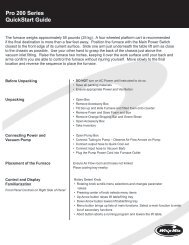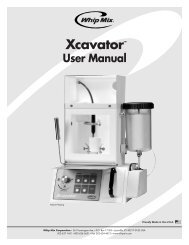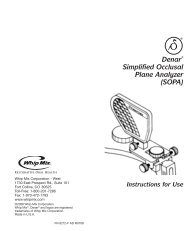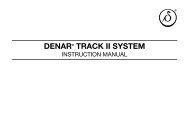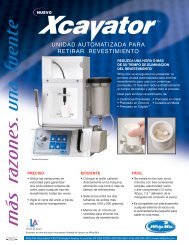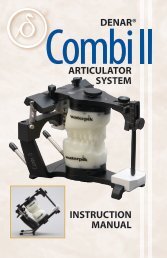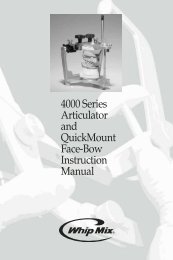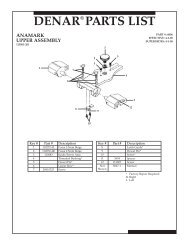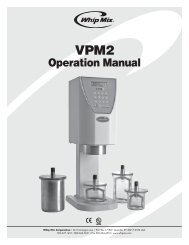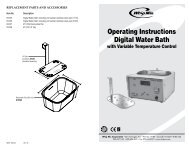Slidematic with Quick Lock Toggle Instructions - Whip Mix
Slidematic with Quick Lock Toggle Instructions - Whip Mix
Slidematic with Quick Lock Toggle Instructions - Whip Mix
You also want an ePaper? Increase the reach of your titles
YUMPU automatically turns print PDFs into web optimized ePapers that Google loves.
<strong>Slidematic</strong> Facebow<br />
<strong>with</strong><br />
<strong>Quick</strong> <strong>Lock</strong> <strong>Toggle</strong> Assembly<br />
Instruction Manual
Table of Contents<br />
I. Rationale for Development ........................................ 2<br />
II. Benefits and Features ................................................ 2<br />
III. <strong>Slidematic</strong> Facebow Procedure ................................. 4<br />
IV. Mounting Procedure .................................................. 6<br />
V. <strong>Slidematic</strong> Accessories .............................................. 8<br />
VI. Reordering ................................................................. 8<br />
VII. Warranty .................................................................... 8<br />
VIII. Care and Maintenance .............................................. 9<br />
1
I. Rationale for Development<br />
The <strong>Slidematic</strong> Facebow <strong>with</strong> <strong>Quick</strong> <strong>Lock</strong> <strong>Toggle</strong> was designed to<br />
satisfy the following requirements:<br />
• An accurate earbow that moves straight horizontally for<br />
different facial widths, unlike the caliper type that moves off the<br />
vertical axis.<br />
• A minimal number of parts and finger screws to permit a<br />
facebow registration to be taken in less time.<br />
• The ability to send the bitefork assembly (<strong>with</strong>out the<br />
measuring bow) to the laboratory, preventing damage to the<br />
bow in transit.<br />
• Ease of mounting the maxillary cast by not having to transfer<br />
the measuring bow to the articulator.<br />
• The capability of taking multiple facebow records at the lowest<br />
possible cost through the use of only one measuring bow and<br />
different bitefork assembly for each case.<br />
II. Benefits and Features<br />
Facebow Transfer<br />
The facebow transfer procedure establishes the relationship of<br />
the maxillary dentition to the horizontal reference plane so that the<br />
maxillary cast may be mounted on the articulator in the correct<br />
anatomical position. The <strong>Slidematic</strong> Facebow provides a fast,<br />
easy and extremely accurate means of transferring the proper<br />
anatomical relationship to the articulator.<br />
Benefits and Features<br />
• The precision manufacturing of the unique “speed-slide” gear<br />
mechanism makes it very easy to assemble the bow on the<br />
patient.<br />
• The right and left arms of the measuring bow are geared to<br />
precise equidistant movement from the center of the bow.<br />
• The scale on the measuring bow represents the patient’s<br />
intercondylar distance (not the interbow distance) for ease in<br />
setting articulators having this adjustment.<br />
• The <strong>Slidematic</strong> Facebow can be used on all Denar ®<br />
articulators. It also adapts for use <strong>with</strong> <strong>Whip</strong> <strong>Mix</strong> ® , and Hanau <br />
articulators.<br />
• The bow uses the external auditory meatus reference point for<br />
determining the arbitrary hinge axis location.<br />
2
• The built-in reference pointer aligns the bow <strong>with</strong> the horizontal<br />
reference plane.<br />
• The built-in sight can be used to view the anterior reference<br />
point.<br />
• The measuring bow cannot be mounted on the articulator during<br />
the transfer procedure. The bow, when detached from the vertical<br />
shaft, can be used again immediately <strong>with</strong> the additional transfer<br />
jigs (vertical shaft, bitefork assembly and articulator index). In this<br />
manner, the maxillary casts may be mounted any time.<br />
NOTE: Follow guidelines for cold sterilization of measuring bow<br />
before reusing (see care and maintenance).<br />
• In one step the bitefork assembly is secured to the articulator<br />
index and the maxillary cast can be mounted to the articulator.<br />
• All finger screws are easily accessible from the front.<br />
• The procedures can be readily delegated to auxiliary personnel.<br />
• The quick lock toggle allows you to easily place the bite fork<br />
adaptor while preventing rotation of the bite fork.<br />
• The quick lock toggle reduces the chance of torquing the<br />
facebow to an absolute minimum.<br />
1<br />
2<br />
2<br />
1<br />
6<br />
3<br />
4<br />
5<br />
Measuring Bow<br />
1. earplug<br />
2. anterior reference pointer<br />
3. intercondylar distance scale<br />
4. “finger” lockscrew<br />
5. center “lock” wheel<br />
6. sight<br />
reference plane locator<br />
3<br />
4<br />
<strong>Quick</strong> <strong>Lock</strong> <strong>Toggle</strong> Assembly<br />
1. dentulous bitefork<br />
2 quick lock toggle<br />
3 vertical shaft<br />
4 articulator index<br />
reference plane marker<br />
Sterilize bitefork before each use.<br />
3
III. <strong>Slidematic</strong> Facebow Procedure<br />
Mark the anterior reference point on the<br />
patient’s right side using the Reference<br />
Plane Locator and Marker. The point is 43<br />
millimeters above the incisal edge of the right<br />
central or lateral incisors (Figure 1). On an<br />
endentulous patient, measure up from the<br />
lower border of the upper lip when it is<br />
in repose.<br />
Cover the bitefork <strong>with</strong> a bite registration<br />
material of your choice. Place the bitefork<br />
in the mouth, aligning the patient’s midline<br />
<strong>with</strong> the index notch, so that it is parallel<br />
<strong>with</strong> the patient’s coronal and horizontal<br />
planes (Figure 2). Be certain to obtain a light<br />
indexing of the patient’s maxillary arch and<br />
then ask the patient to hold the bitefork in<br />
place or place a cotton roll between the<br />
bitefork and the mandibular teeth.<br />
Note: The bitefork can be used <strong>with</strong> the<br />
arm on either the right or left side of the<br />
vertical shaft.<br />
Ensure the arm of the ball fits inside the slot<br />
of both sleeves on the quick lock toggle<br />
assembly. This ensures the quick lock toggle<br />
assembly has the fullest range of movement<br />
anteriorly/posteriorly (Figure 3).<br />
Attach the vertical shaft to the measuring<br />
bow <strong>with</strong> the flat side of the shaft closest to<br />
the patient (Figure 4). Tighten <strong>with</strong> the finger<br />
screw on the front of the measuring bow.<br />
The upper sleeve of the quick lock toggle<br />
will be parallel to the shaft <strong>with</strong> the black #2<br />
knob either to the right or left of the shaft. It<br />
is necessary to tighten the finger screw on<br />
the measuring bow to secure the vertical<br />
shaft and also to avoid movement.<br />
Figure 1<br />
Figure 2<br />
Figure 3<br />
Figure 4<br />
4
We encourage you to rehearse the<br />
following steps <strong>with</strong> the patient so they<br />
can become familiar <strong>with</strong> the procedure<br />
and offer assistance as needed.<br />
Loosen knob #1 slightly so that it will easily<br />
slide over the arm of the bitefork. With your<br />
thumb, loosen the center wheel on top of<br />
the measuring bow and slide the bow open<br />
to accommodate the width of the patient’s<br />
face. Place the earpieces in the patient’s<br />
auditory meatus and hold in place <strong>with</strong> a<br />
firm forward pressure (Figure 5). Tighten the<br />
center wheel on the measuring bow.<br />
With one hand holding the measuring bow<br />
or <strong>with</strong> the patient’s assistance holding the<br />
bow, attach the quick lock toggle assembly<br />
to the bitefork, <strong>with</strong> the #1 knob facing<br />
down. <strong>Lock</strong> into place using the #1 knob<br />
(Figure 6).<br />
Loosen the screw on the anterior reference<br />
pointer. Raise or lower the bow so that the<br />
pointer or sight aligns precisely <strong>with</strong> the<br />
anterior reference point marked earlier. <strong>Lock</strong><br />
the quick lock toggle assembly by tightening<br />
knob #2 located at the center of the toggle<br />
assembly (Figure 7).<br />
Check to ensure that the measuring bow is<br />
parallel to the horizon, either using a bubble<br />
level or <strong>with</strong> visual verification. Ensure the<br />
quick lock toggle assembly is firmly locked<br />
in place (Figure 8).<br />
The patient’s intercondylar distance is<br />
the measurement indicated on the scale.<br />
Record this measurement if using an<br />
articulator <strong>with</strong> this adjustment (Figure 9).<br />
Loosen the center wheel on top of the<br />
measuring bow, slide the bow open, and<br />
remove the entire facebow from the patient.<br />
Figure 5<br />
Figure 6<br />
Figure 7<br />
Figure 8<br />
Figure 9<br />
5
Detach the measuring bow from the quick<br />
lock toggle assembly by loosening the finger<br />
screw on the front of the measuring bow.<br />
Having completed the procedures involving<br />
the patient, the quick lock toggle assembly<br />
may be labeled <strong>with</strong> the patient’s name and<br />
set aside while the measuring bow may be<br />
used <strong>with</strong> an additional quick lock toggle<br />
assembly for the next patient (Figure 10).<br />
Note: The metal bitefork and earpieces<br />
can be sterilized in an autoclave. DO NOT<br />
autoclave the measuring bow <strong>with</strong> levels<br />
attached.<br />
Figure 10<br />
Sterilize bitefork before each use.<br />
IV. Mounting Procedure<br />
A benefit of using the Denar ® <strong>Slidematic</strong><br />
Facebow is that multiple quick lock toggle<br />
assemblies may be used <strong>with</strong> only one<br />
measuring bow. In some cases the mounting<br />
of the maxillary cast can be delegated<br />
to the laboratory, involving no loss of accuracy<br />
and no period of time <strong>with</strong>out facebow<br />
transfer capability in the dental office. The<br />
laboratory can attach an articulator index<br />
to its own Denar ® articulator and mount the<br />
maxillary cast using only the quick lock toggle<br />
assembly from the dental office. Each<br />
articulator index positions the quick lock<br />
toggle assembly on any Denar ® articulator<br />
so that the relationship <strong>with</strong> the condyles<br />
recorded on the patient is accurately reproduced<br />
on the articulator.<br />
Mounting The Maxillary Cast<br />
Replace the incisal table on the articulator<br />
<strong>with</strong> the articulator index (Figure 11). With<br />
the clamp on the vertical shaft at the top<br />
of the shaft, secure the lower part of the<br />
vertical shaft in the hole of the articulator<br />
index. Tighten the finger screw on the front<br />
edge of the index (Figure 12).<br />
Figure 11<br />
Figure 12<br />
Attach a mounting plate to the upper bow.<br />
Be sure that the incisal pin is at the zero<br />
6
position and that the upper bow is level and<br />
parallel to the table top.<br />
Your articulator comes <strong>with</strong> a standard<br />
incisal pin guide. When using standard<br />
incisal pins, the incisal pin should set on top<br />
of the movable slide insert on the articulator<br />
index (Figure 13). When using the incisal<br />
pin <strong>with</strong> the long centric adjustment the<br />
pin should rest on the lowest point of the<br />
articulator index.<br />
Tip: To avoid confusion and in cases where<br />
the standard pin is utilized exclusively, lock<br />
the slide insert in the correct position <strong>with</strong> a<br />
drop of wax or acrylic.<br />
Place the maxillary cast in the bite<br />
registration index on the bitefork, close<br />
the articulator, and mount the cast <strong>with</strong><br />
mounting stone to the mounting plate<br />
(Figure 14). It is recommended that you use<br />
a maxillary cast support to prevent flexing<br />
of the bite fork during the cast mounting<br />
procedure. Once the stone has hardened,<br />
remove the transfer jig and replace the<br />
incisal table in the articulator.<br />
Mounting The Mandibular Cast<br />
Attach a mounting plate to the lower bow. A<br />
centric relation bite record is used to mount<br />
the mandibular cast. With the maxillary<br />
cast attached to the articulator and the<br />
centric latch engaged, invert the articulator<br />
and place the centric relation bite record<br />
between the maxillary and mandibular casts<br />
(Figure 15). Stabilize the position of the casts<br />
<strong>with</strong> one of the following: glue gun, coat<br />
hanger wire, large paper clips. Adjust the<br />
incisal pin to accommodate the increased<br />
vertical distance caused by the thickness<br />
of the centric relation bite record. Double<br />
check to be certain that the condyles<br />
are seated against the rear and tops of<br />
the fossae, and using mounting stone,<br />
proceed to mount the madibular cast to the<br />
mounting plate on the articulator (Figure 16).<br />
Figure 13<br />
Figure 14<br />
Figure 15<br />
Figure 16<br />
7
V. <strong>Slidematic</strong> Accessories<br />
The <strong>Slidematic</strong> Facebow can be used <strong>with</strong> other articulators and<br />
indexes are available for the Hanau and <strong>Whip</strong> <strong>Mix</strong> ® models.<br />
Standard Bitefork<br />
Indexes<br />
VI. Reordering<br />
Standard Biteforks<br />
Part No. 200038 Dentulous<br />
Articulator Indexes<br />
Part No. 200080 Denar ®<br />
200082 Hanau <br />
200088 <strong>Whip</strong> <strong>Mix</strong> ®<br />
200088Q <strong>Whip</strong> <strong>Mix</strong> ® <strong>Quick</strong>Mount<br />
Other<br />
Part No. 200018-1 <strong>Quick</strong> <strong>Lock</strong> <strong>Toggle</strong><br />
Assembly<br />
200008 Bitefork/Shaft<br />
Assembly<br />
003401-000 Maxillary Cast<br />
Support<br />
Denar ® and <strong>Whip</strong> <strong>Mix</strong> ® are registered trademarks and Hanau is a trademark of<br />
<strong>Whip</strong> <strong>Mix</strong> Corporation.<br />
VII. Warranty<br />
<strong>Whip</strong> <strong>Mix</strong> Corporation warrants the <strong>Slidematic</strong> Facebow to be<br />
free from defects in material and/or workmanship for a period<br />
of one year. In the event of a defect, please notify the factory in<br />
writing of the defect prior to returning the instrument. <strong>Whip</strong> <strong>Mix</strong><br />
Corporation will, at its option, either repair, replace or issue credit<br />
for such defects.<br />
Because <strong>Whip</strong> <strong>Mix</strong> Corporation is continually advancing the<br />
design of its products and manufacturing methods, it reserves<br />
the right to improve, modify or discontinue products at any time,<br />
or to change specifications or prices <strong>with</strong>out notice and <strong>with</strong>out<br />
incurring obligations.<br />
8
VIII. Care and Maintenance<br />
1. The metal bitefork can be sterilized in an autoclave. Since the<br />
bite fork is made out of metal and is the only part used inside<br />
the oral cavity it should be sterilized before each use. Due to<br />
the availability of several different models of sterilization and<br />
autoclaving equipment on the market it is important that you<br />
follow their recommendations for time and temperature for<br />
the materials being sterilized, but do not exceed 375˚ F or 30<br />
minutes. Cold sterilize the ear pieces.<br />
2. The quick lock toggle shaft assembly should be cleaned<br />
<strong>with</strong> an EPA-registered hospital disinfectant <strong>with</strong> low to<br />
intermediate-level (tuberculocidal claim) activity. Do not<br />
autoclave or run this shaft assembly through a dishwasher.<br />
3. Clean and properly disinfect the facebow apparatus before<br />
each use. Do not autoclave the bow <strong>with</strong> level attached.<br />
4. A finger cot placed over each earpiece will help facilitate<br />
proper disinfection of the facebow.<br />
9
<strong>Whip</strong> <strong>Mix</strong> Corporation<br />
361 Farmington Avenue<br />
Louisville, KY 40209<br />
Toll-Free: 1-800-626-5651<br />
Fax: 1-502-634-4512<br />
www.whipmix.com<br />
EU Representative<br />
<strong>Whip</strong> <strong>Mix</strong> Europe GmbH<br />
Raudestraße 2<br />
D-44141 Dortmund<br />
Germany<br />
Phone: 49 231 567 70 8-0<br />
Fax: 49 231 567 70 8-50<br />
For International Customers:<br />
U.S. Phone: 1-970-472-1635<br />
Denar ® and logo are registered trademarks<br />
of <strong>Whip</strong> <strong>Mix</strong> Corporation<br />
©2010 <strong>Whip</strong> <strong>Mix</strong> Corporation<br />
U.S. Patent Nos. 4,836,779; 5,009,594<br />
FN 8058-F AA 1010





